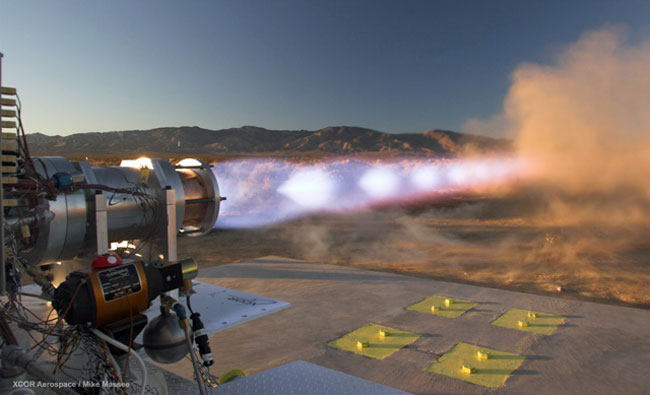Methane Rocket Engine Successfully Tested

Engineers have successfully tested a rocket powered by methane--the first of its kind for spaceflight. Future generations of the new engine could use Mars, Jupiter, Saturn's moon Titan and other planets and moons as celestial refueling stations, allowing for lighter spacecraft and easier lift-offs from Earth.
A dramatic video shows the rocket's blue flames streaking into the desert, blowing up clouds of dust and sand.
Built by XCOR Aerospace, the test rocket packs 7,500 pounds of thrust--just a fraction of the space shuttle's solid rocket boosters at 3,300,000 pounds of thrust each--but its designers are just getting started. The Mojave Desert test will provide testing grounds for the design of a much-larger, space-faring rocket.
Today's space rockets use liquid oxygen and hydrogen or solid fuels, which are hard to collect, tricky to store and very expensive. Methane, however, need not be stored at -253 degree Celsius temperatures as hydrogen must be. It's also denser than hydrogen, making more out of limited space in fuel containers.
Methane has another bonus: "You don't have to put on a HAZMAT suit to handle it like fuels used on many space vehicles, said Terri Tramel, NASA's project manager for the rocket.
Collecting methane on other planets and moons would be tricky, but not impossible. Robotic probes could gather the stuff from Saturn's moon Titan, which harbors lakes and rivers of liquid methane. Although Mars has much less methane, it could be produced by heating carbon dioxide and hydrogen together.
One caveat to methane is that it's difficult to ignite, unlike highly reactive oxygen and hydrogen. But rocket engineers are hopeful. "Methane has so many advantages," Tramel said. "The question is, why haven't we done this before?"
Get the Space.com Newsletter
Breaking space news, the latest updates on rocket launches, skywatching events and more!
- See the Video: New Rocket Test Fire
- Methane Rocket Fuel: A Lot of Hot Gas and Nowhere to Blow
Join our Space Forums to keep talking space on the latest missions, night sky and more! And if you have a news tip, correction or comment, let us know at: community@space.com.
Dave Mosher is currently a public relations executive at AST SpaceMobile, which aims to bring mobile broadband internet access to the half of humanity that currently lacks it. Before joining AST SpaceMobile, he was a senior correspondent at Insider and the online director at Popular Science. He has written for several news outlets in addition to Live Science and Space.com, including: Wired.com, National Geographic News, Scientific American, Simons Foundation and Discover Magazine.









